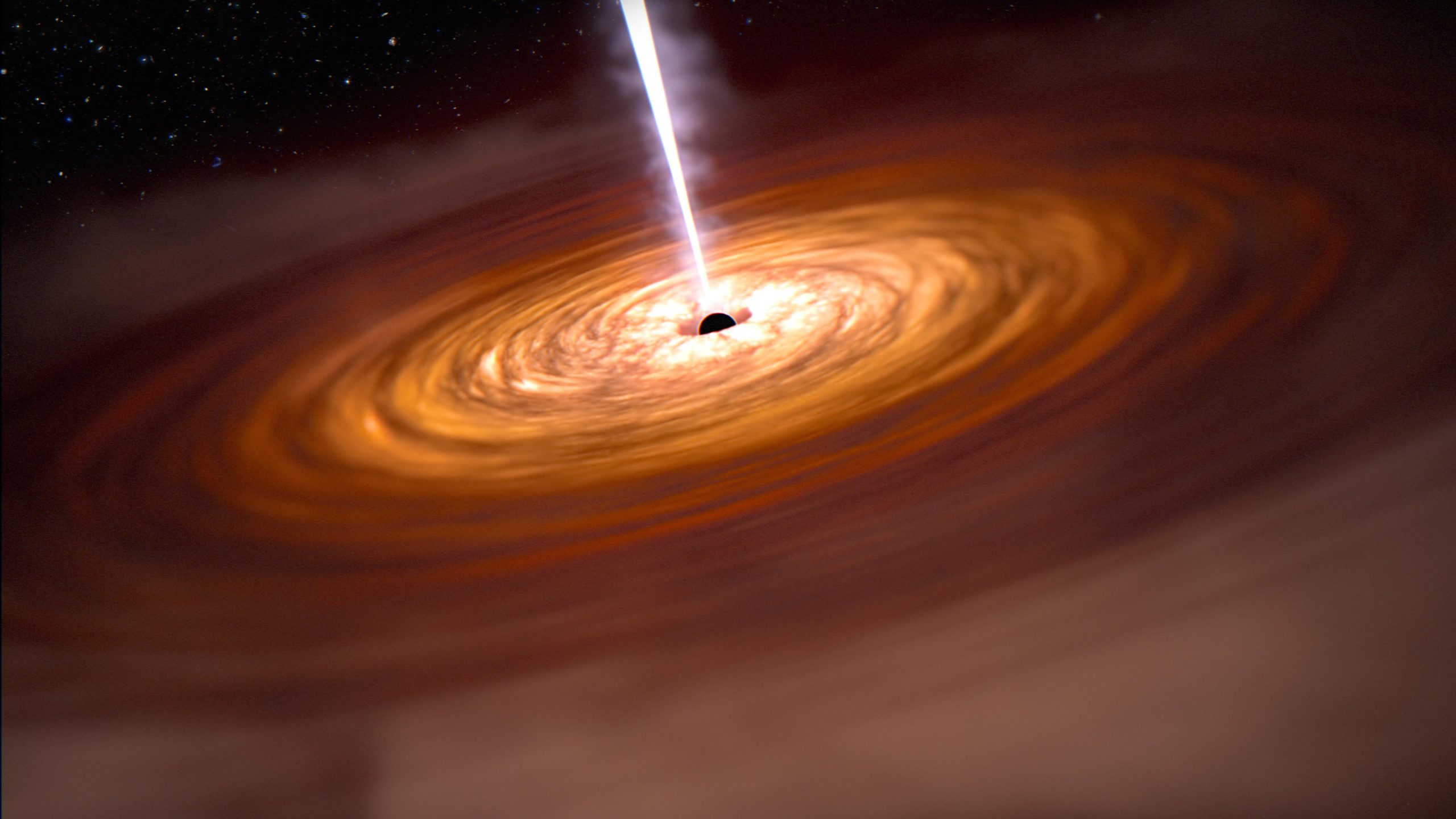퀘이사와 퀘이사를 둘러싼 은하의 삽화. 셰필드 대학과 하트퍼드셔 대학 과학자들의 연구에 따르면 우주에서 가장 밝고 강력한 물체인 퀘이사는 충돌하는 은하에 의해 점화됩니다. 이 발견은 퀘이사가 어떻게 작동하고 영양분을 섭취하는지 이해하는 데 중요한 통찰력을 제공하여 우주의 역사와 은하수의 미래에 대한 지식에 기여합니다. 크레딧: NASA, ESA, CSA, 조셉 옴스테드(STScI)
과학자들은 충돌하는 은하에 의해 점화된다는 사실을 발견함으로써 우주에서 가장 밝고 강력한 물체인 퀘이사의 가장 큰 미스터리 중 하나를 밝혀냈습니다.
- 60년 전에 처음 발견된 퀘이사는 우리 태양계 크기의 부피에 채워진 1조 개의 별만큼 밝게 빛날 수 있지만 지금까지 무엇이 그러한 활발한 활동을 촉발할 수 있는지는 미스터리로 남아 있습니다.
- 퀘이사가 있는 48개의 은하를 관찰하고 퀘이사가 아닌 100개 이상의 은하와 비교함으로써 과학자들은 이 현상이 충돌하는 은하에 의해 촉진된다는 것을 발견했습니다.
- 두 은하가 충돌할 때, 중력은 충돌로 인해 발생하는 잔류 은하계의 중심에 있는 초대질량 블랙홀을 향해 엄청난 양의 가스를 밀어냅니다.[{” attribute=””>black hole, it releases extraordinary amounts of energy in the form of radiation, resulting in a quasar
- The Milky Way is likely to experience its own quasar when it collides with the Andromeda galaxy in roughly five billion years’ time
First discovered 60 years ago, quasars can shine as brightly as a trillion stars packed into a volume the size of our Solar System. In the decades since they were first observed, it has remained a mystery what could trigger such powerful activity. New work led by scientists at the Universities of Sheffield and Hertfordshire has now revealed that it is a consequence of galaxies crashing together.
The collisions were discovered when researchers, using deep imaging observations from the Isaac Newton Telescope in La Palma, observed the presence of distorted structures in the outer regions of the galaxies that are home to quasars.
Most galaxies have supermassive black holes at their centers. They also contain substantial amounts of gas – but most of the time this gas is orbiting at large distances from the galaxy centers, out of reach of the black holes. Collisions between galaxies drive the gas towards the black hole at the galaxy center; just before the gas is consumed by the black hole, it releases extraordinary amounts of energy in the form of radiation, resulting in the characteristic quasar brilliance.
The ignition of a quasar can have dramatic consequences for entire galaxies – it can drive the rest of the gas out of the galaxy, which prevents it from forming new stars for billions of years into the future.
This is the first time that a sample of quasars of this size has been imaged with this level of sensitivity. By comparing observations of 48 quasars and their host galaxies with images of over 100 non-quasar galaxies, researchers concluded that galaxies hosting quasars are approximately three times as likely to be interacting or colliding with other galaxies.
The study has provided a significant step forward in our understanding of how these powerful objects are triggered and fueled.
Professor Clive Tadhunter, from the University of Sheffield’s Department of Physics and Astronomy, said: “Quasars are one of the most extreme phenomena in the Universe, and what we see is likely to represent the future of our own Milky Way galaxy when it collides with the Andromeda galaxy in about five billion years.
“It’s exciting to observe these events and finally understand why they occur – but thankfully Earth won’t be anywhere near one of these apocalyptic episodes for quite some time.”
Quasars are important to astrophysicists because, due to their brightness, they stand out at large distances and therefore act as beacons to the earliest epochs in the history of the Universe. Dr. Jonny Pierce, Post-Doctoral Research Fellow at the University of Hertfordshire, explains:
“It’s an area that scientists around the world are keen to learn more about – one of the main scientific motivations for NASA’s James Webb Space Telescope was to study the earliest galaxies in the Universe, and Webb is capable of detecting light from even the most distant quasars, emitted nearly 13 billion years ago. Quasars play a key role in our understanding of the history of the Universe, and possibly also the future of the Milky Way.”
Reference: “Galaxy interactions are the dominant trigger for local type 2 quasars” by J C S Pierce, C Tadhunter, C Ramos Almeida, P Bessiere, J V Heaton, S L Ellison, G Speranza, Y Gordon, C O’Dea, L Grimmett and L Makrygianni, 13 February 2023, Monthly Notices of the Royal Astronomical Society.
DOI: 10.1093/mnras/stad455

“경순은 통찰력 있고 사악한 사상가로, 다양한 음악 장르에 깊은 지식을 가지고 있습니다. 힙스터 문화와 자연스럽게 어우러지는 그의 스타일은 독특합니다. 그는 베이컨을 좋아하며, 인터넷 세계에서도 활발한 활동을 보여줍니다. 그의 내성적인 성격은 그의 글에서도 잘 드러납니다.”
